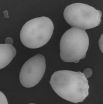In the Jan. 10, 2011, issue of the Journal of Experimental Medicine, researchers from the University of Chicago and Emory University report that people who were infected with pandemic H1N1 and recovered had an extraordinary immune response, producing antibodies that are protective against a variety of flu strains.
The 2009 H1N1 virus matched typical influenza strains only in the components that are absolutely critical for the virus to function. It induced an immune response to those components that overlapped with prior influenza exposures. Incorporating these defenses--focused on the virus's most essential molecules--into a vaccine could put an end to the yearly scramble to predict coming flu strains and quickly mass produce a different vaccine each fall.
"The result is something like the Holy Grail for flu-vaccine research," said study author Patrick Wilson, PhD, assistant professor of medicine at the University of Chicago. "It demonstrates how to make a single vaccine that could potentially provide immunity to all influenza. The surprise was that such a very different influenza strain, as opposed to the most common strains, could lead us to something so widely applicable."
"Our data show that infection with the 2009 pandemic influenza strain could induce broadly protective antibodies that are only very rarely seen after seasonal flu infections or flu shots," said first author of the study, Jens Wrammert, PhD, assistant professor of microbiology and immunology at Emory University School of Medicine and the Emory Vaccine Center. "These findings show that these types of antibodies can be induced in humans, if the immune system has the right stimulation."
When the study began, there was no vaccine for the novel 2009 H1N1 strain. The researchers hoped to use the antibodies from patients who recovered as therapy for those who were severely ill with this emerging virus.
The researchers began by analyzing antibody responses from nine patients recruited through the Hope Clinic, the clinical division of the Emory Vaccine Center. In these patients, ages 21 to 45 years old, the virus caused a range of illness, from mild to life-threatening disease.
The researchers identified white blood cells from the patients that made antibodies against the virus, then isolated antibody genes from individual cells. They used the genes to produce antibodies—a total of 86 varieties—and then tested which flu strains the antibodies reacted against.
Five antibodies isolated by the team could bind all the seasonal H1N1 flu strains from the last decade, the devastating "Spanish flu" strain from 1918, plus a potentially lethal H5N1 avian flu strain.
This indicated that "while the flu changes from year to year, some core elements have been consistent for nearly a century," said Wilson.
The cross-reactive antibodies were produced by highly mutated antibody genes. These antibodies appear to have been produced by white blood cells that had been exposed to influenza in previous years and were reactivated by a new viral infection. As the antibody genes, developed to combat one strain, adapted to a new infection, they continued to mutate, increasing their affinity for certain key targets present on both strains.
Half of the cross-reactive antibodies the team identified attached to the virus's "stalk" region, a sort of biochemical drill-bit the virus uses to enter cells. Because this part of the virus doesn't change as much as other regions, scientists have proposed to make it the basis for a vaccine that could provide broader protection.
"Previously, this type of broadly protective, stalk-reactive antibody was thought to be very rare," Wrammert said. "In contrast, in the patients we studied, these stalk-reactive antibodies were surprisingly abundant."
The team tested whether three of their cross-reactive antibodies could protect mice against the 2009 strain or two other common lab strains. Two antibodies protected mice against an otherwise lethal dose of any of the three strains, even when the antibody was given 60 hours after infection.
One antibody, from the patient with the most severe illness, only protected against the 2009 H1N1 strain. The antibody genes from that patient suggest that the patient had a complete lack of preexisting immunity to H1N1 viruses. In cases where patients experienced a milder illness, it appears that immune cells that developed in response to previous seasonal flu shots or infections formed a foundation of response to 2009 H1N1 strain.
Although relatively few patients could be analyzed in detail at the antibody level, the authors conclude that "with the proper immunogen, the long-sought development of a pan-influenza vaccine might be possible."
Next, the research team is planning to examine the immune responses of people who were vaccinated against the 2009 H1N1 strain but did not get sick to see if they also produce antibodies that protect against many influenza strains.
INFORMATION:
Funded by the National Institute of Allergy and Infectious Diseases, part of the National Institutes of Health, and by the American Recovery and Reinvestment Act of 2009, the research comes from a collaboration between the laboratories of Rafi Ahmed, PhD, director of the Emory Vaccine Center and Patrick Wilson, at the University of Chicago's Knapp Center for Lupus and Immunology Research. Drs. Ahmed, Wrammert and Wilson, and Emory University and the University of Chicago, are entitled to royalties derived from the sale of products related to the research described in this paper. This study could affect their personal financial status.
Additional authors include Michael Morrissey, Nai-Ying Zheng, Jane-Hwei Lee, Min Huang, Zahida Ali, Kaval Kaur, and Sara Andrews from the University of Chicago; Dimitrios Koputsananos, Gui-Mei Li, Srilatha Edupuganti, Megan McCausland, Ionna Slountzou, Behzag Razavi. Carlos Del Rio, Rama Rao Amara, Youliang Wang, Mark Mulligan, Richard Compans, and Aneesh Mehta of Emory University; Mady Hornig and Ian Lipkin of Columbia University; Jinhua Sui and Wayne Marasco of Harvard Medical School; Suman Das, Christopher O'Donnell, Jon Yewdell and Kanta Subbarao of the National Institutes of Health.
END

